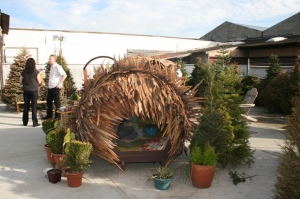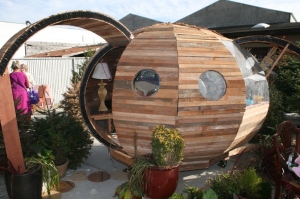Some time ago, I took a tour at the transfer station where San Francisco’s garbage is disgorged from regular garbage trucks into a giant pit and then stuffed into huge trailers that take it all to Livermore. The pit is a thing to behold, nauseating and overpowering. It’s pretty full, said our guide, despite the fact that it’s a Saturday. It’s dark inside, even infernal. Trucks come and go, spewing out trash. More garbage pours out of a chute in a corner. Gulls are quietly biding their time until appetite strikes again.

But the transfer station also offers a much more cheerful perspective on our stuff, a more whimsical and touching commentary on the multfarious burdens of wealth and consumerism. The sculpture garden, paradoxically peaceful and verdant, holds a compelling collection of art patched together out of materials snatched from the abyss by resident artists.

Even better is art hill, the higgledy-piggledy collection of junk that workers have rescued from perdition. There’s a traffic jam of Tonka trucks, whose vaunted indestructibility sooner or later stops counting as an advantage. There’s a sky-blue David, not quite two feet high, but every bit as languidly elegant as the original incarnation. There’s an outsize tiger, an unraveling bolt of unidentifiable beast, a dragon with a weirdly articulated tail, a menagerie of birds and saints and garden gnomes, arranged around and half-hid between a luxuriant patch of dog-eared cacti.
This gallery of the unwanted is stocked from the shed where private individuals do away with supernumerary household goods from attics and basements, where home remodelers unburden themselves of the debris inevitably attendant upon their projects. When I visited on an earlier occasion,hat he lacked in legs was amply made up for in the pinup behind him, of two young women displaying more leg than a normal human being would know what to do with.

Other items on art hill come from the little outside area where the city brings trash that has been found abandoned in the street. It’s easy to get censorious and start thinking about the antisocial element that just saddle us, more conscientious citizens, with their messes. But some of these things—desks, strollers, file cabinets, TV stands—could be part of our informal freecycle efforts. We’ve all seen how it works. Somebody puts some poor old thing by the curb with a little sign on it inviting passersby to take mercy. Of course the city may get to the foundling possession and cart it off before a good Samaritan has had a chance to clasp it to his breast.All of this tells an inarticulate story about the embarrassment of riches, the quiet dilemmas involving our stuff, especially the in-between things that have lost their new-bought sheen but aren’t yet garbage. If it’s not utterly hopeless, irreparably broken, contaminated, or otherwise just plain used up, if it’s not recyclable or compostible, then what to do? For most of us, it doesn’t just slide down the slope towards garbage oblivion without internal debate or pang of conscience, especially if it’s a little large for the garbage can.
Even if they are not adopted as a new owner’s prized possession, it’s something of a consolation that some of these things don’t get buried at Altamont but end up in this museum of buyer’s remorse, with blue David and the toucan. All the same, perhaps it’s time to remember caveat emptor.




